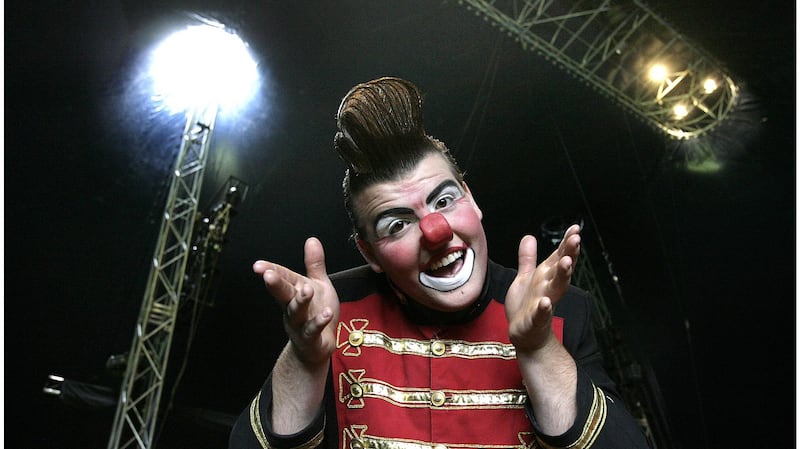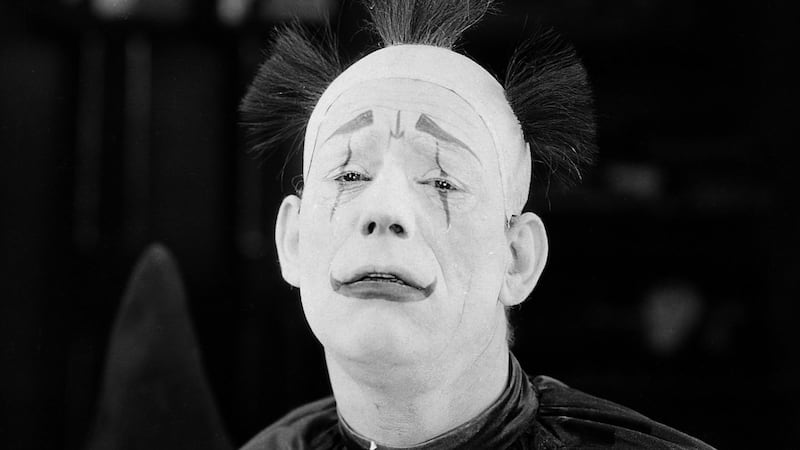Otto the Clown, aka Edward Fossett Junior, is a fifth generation performer at Fossett's Circus. At the height of last year's clown-related hysteria – no, there's no such thing as the Darndale Clown, folks – he found himself fielding inquiries from the media and paying customers.
“When it was a big thing this time last year I’d end up having that conversation a couple of times during every show,” says Otto. “Kids would come up and say: ‘Are you a killer clown?’ and I’d say: ‘No, those are just crazy people with masks; they’re not real clowns’. There’s not many kids who are afraid of me. And if they are, I approach them, and by the end they’ll warm to me.”
Against received wisdom, Otto, who describes himself as "a big Stephen King fan" is looking forward to the new movie version of IT, although "not as much as The Dark Tower: that's the one I can't wait to see".

Others in his profession are less keen on the revival of Pennywise, the evil, sewer-dwelling harlequin at the dark heart of King's 1986 novel. Last week, World Clown Association (WCA) president Pam Moody spoke to The Hollywood Reporter about the "good clowns" who are losing work due to the new adaptation.
“Last year we were really blindsided,” says Moody of the great creepy clown blitz of 2016. “People had school shows and library shows that were cancelled.”
That initial wave of US sightings quickly crossed the Atlantic and saw several schools, including Holy Trinity College in Cookstown, placed on lockdown last October. In response to the hysteria, the WCA created a press kit, one, it is hoped, will help professional clowns prepare for the new movie.
"It should be understood to be a fantasy character," insists the press kit, "and not a true clown".
Stephen King, in turn, has tweeted: “BUT...kids have always been scared of clowns. Don’t kill the messengers for the message.”
Couldrophobia
The Maine-born author is not wrong. Coulrophobia, an intense fear of clowns, may have risen up the ranks in recent years – one UK-based study places an irrational fear of clowns just behind spiders and needles in the phobia hit parade – but the long history of clowning points to an adjacent history of freaked out spectators.
Throughout the ages, fools and jesters have frequently been associated with unbridled appetites and uncensored opinions. In Ancient Greece, clowns wore short tunics ("chiton") and giant strap-on phalluses; in imperial China, the jester YuSze was the only member of court allowed to criticise Emperor Qin Shih Huang; in Ancient Rome, the 'stupidus' traded in sexual innuendo and fights.
Ridiculing people's weight or bad toupees is all part of the fun, part of the act – but we don't know what the clown really thinks
In his award-winning book Bad Clowns (University of New Mexico), Benjamin Radford, the popular TV skeptic and author, chronicles the American carnival tradition of the "dip clown".
“Dip clowns or dunk tank clowns, insult passersby at fairs,” says Radford. “Ridiculing people’s weight or bad toupees is all part of the fun, part of the act – but we don’t know what the clown really thinks. Is the clown just pretending to be vile and nasty, or is he really like that? We love evil clowns because they embody fascinating contradictions of humour and horror.”

Radford suggests that Stephen King may have helped popularise the scary clown archetype, but he certainly didn't invent it. Evil clown films date back to the silent era, when Lon Chaney Sr starred in He Who Gets Slapped (1924). Indeed, by the time the Chiodo Brothers premiered the Killer Klowns from Outer Space (in 1988) and Tim Curry essayed Pennywise in the 1990 miniseries of IT, the serial killer and rapist John Wayne Gacy had sexually assaulted, tortured and murdered at least 33 teenaged boys and young men between 1972 and 1978, sometimes dressed as a clown. "You know, clowns can get away with murder," he told detectives before his execution in 1994.

"It's misleading to ask when clowns turned bad, for they were never really good," says Radford. "Clowns and jesters have always been ambiguous characters, neither clear heroes nor villains but sometimes either or both at different times as suits their murky purposes. The evil clown character may have flourished and found new fame over the past few decades, but there is nothing new about it. Mythologist Joseph Campbell, in his classic The Hero With a Thousand Faces, notes that in mythology the clown and evil are inextricably linked:"Universal too is the casting of the antagonist, the representative of evil, in the role of the clown. Devils – both the lusty thickheads and the sharp, clever deceivers – are always clowns."
Psychoanalytical trope
The Freudian id is not the only psychoanalytical trope in play. In his (increasingly voguish) 1919 paper, The Uncanny, Sigmund Freud postulates that we are frightened by something that is simultaneously familiar and yet unfamiliar, a thesis that finds parallels in contemporary neurological research into fear and pattern recognition. Clowns, by this account, are both recognisably human, yet visibly distorted, what with those elongated feet and bulbous noses.
The painted on smile – or frown in the case of the great Irish-American hobo clown, Emmett Kelly – adds to that sense of distortion and untrustworthiness. There is a story that jesters were often maimed during the Middle Ages to produce a permanent smile, but the source for this story may actually be Victor Hugo 1869 novel The Man Who Laughs.
The idea of the secretly tragic clown has real world antecedents in Jean-Gaspard Deburau's Pierrot, the 19th century Bohemian-French mime who killed a teasing boy with "one blow of his cane", and fictional correlatives in the 1892 Italian opera Pagliacci.
Most of our current ideas about the sad clown, however, come to us from Charles Dickens. As a young writer, Dickens was tasked with editing the memoirs of the late Joseph Grimaldi, the wildly popular, early 19th century comic, and progenitor of the modern clown.
Dickens quotes Grimaldi in the book as saying: “I am grim all day, and yet I make you laugh all night”, a phrase that neatly encapsulates Grimaldi’s tragic life-history. Grimaldi had grown up with a tyrannical stage father known as the “Signor”; he was already prone to depression when his first wife died during childbirth; his alcoholic son was dead by the age of 31; his innovative slapstick left him with chronic, debilitating injuries.
"Dickens is really the progenitor of two different strands that gain traction in the late 19th and early 20th centuries," says Andrew McConnell Stott, an English professor at the University of Southern California and the author of The Pantomime Life of Joseph Grimaldi. "The first is the idea of using humour as a form of compensation for some psychic wound. You see this sad clown trope all the time. Most recently with Jerry Lewis. A comic driven by some internal demons or defining sadness.
Thin veneer
The second idea Dickens perpetuates is of a clown having a very thin veneer of humour, that when you begin to scratch at the surface, it turns into something more terrifying. Dickens created the first horror clown. You can trace a line between Stephen King’s IT and Gemmy the clown in The Pickwick Papers, this emaciated, skeletal,unhealthy, dissolute character who is tortured by inner demons. Gemmy is a marginal figure in the book, but the character was informed by what Dickens knew of the theatre and of the lifestyles of the performers there. He was very interested in the difference between stage and off-stage. How the lighting and the make up and the costumes could create a wondrous spectacle. But in the cold light of day, you had child performers drinking gin from the age of ten. The horror clown is an exaggeration of these observations, and it mines the difference between the reality and this unproblematic figure of fun.”
This paradox may account for the contradictions found across various scientific studies into clowning. An Italian study from the Journal of Health Psychology in 2013 found that clown-doctor intervention significantly reduced preoperative anxiety in children hospitalised for minor surgery. Conversely, a 2008 survey of 250 children between the ages of four and 16 for the University of Sheffield found that most of the children disliked and even feared images of clowns. Writing in Nursing Standard, researcher Dr Penny Curtis did not mince words: "We found that clowns are universally disliked by children. Some found them quite frightening and unknowable."
Rival entertainer
Andrew McConnell Stott suggests that the clown epidemic may be related to an orange-haired, rival entertainer.
"It all peaked during the election period," says McConnell Stott. "I think if you look at the heightened absurdity in contemporary American political discourse and public discourse, the clues are there. Something I thought fascinating is that scary clowns were sighted primarily in at-risk communities, like rust-belt communities or rural communities; places that have been hollowed out by economic stress. Scary clowns were seen on the peripheries of these communities; they didn't go up to people and wave knives in their faces,. They were glimpsed in windows or stood under streetlamps. Just enough to freak everybody out, but not to endanger them. Reminders of a previous age. The return of the repressed. And then. Donald Trump was elected and the clowns were never seen again."
When you think about classic horror monsters – vampires, werewolves Frankenstein - you now have scary clowns.
Can clowns ever be figures of fun again? Assuming, indeed, that they ever were? The professor does not necessarily see a way back for the pasty-faced entertainers of old: “Clowns have now passed onto the pantheon of horror monsters,” he says. “That’s an interesting shift. When you think about classic horror monsters – vampires, werewolves Frankenstein - you now have scary clowns. That’s what they are predominantly known for. That’s the primary relationship people have with clowns.”
- IT is on general release today, September 8th.






















